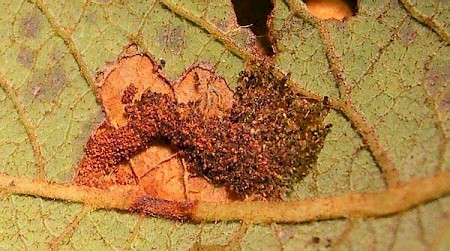49.279 BF1169
Gypsonoma dealbana
(Frölich, 1828)
Wingspan 11-14 mm.
This species can be distinguished from other Gypsonoma species by the creamy-white patch on the front of the head, which is pure white in G. sociana, and darker on others.
It is widely distributed over England, Wales and Ireland, though commoner in the south.
The normal flight period is July and August, when the moths fly from dusk onwards.
The larvae feed on a range of deciduous trees, windowing leaves in autumn and eating the buds, catkins, young shoots and then spun leaves in the spring.
- Larva: (Description:Ian F Smith):
Foodplants: Salix, Populus, Crataegus, Quercus, Corylus and many other trees and shrubs. The young larva lives in a silk tube inside a club shaped habitation of silk covered in frass and plant fragments.
The habitation is attached to the underside of a leaf, which is 'windowed' by the larva feeding in September and early October. After winter diapause in a tube on a twig, feeding continues in April in buds or catkins and then, in May and early June, in spun shoots and leaves.
Pupation usually takes place in June and emergence in July. A full-grown larva found on 21st August 2004, which pupated on 23rd August and emerged 15th September, shows that sometimes there is a second generation, so development may be in advance of the times mentioned. (Information acknowledged with thanks, from C. Darbyshire, S. Farrell and J. Langmaid).
Length: Prepupation final instar, about 6 mm, described.
Head: Black (BTS; yellowish brown to black), mouthparts pitchy brown.
Prothorax (T1): Black prespiracular sclerite. Prothoracic shield pitchy black (BTS; sometimes brown with darker margins). Divided by whitish medial line.
Thoracic legs: Black (BTS dark brown) with pale joints. Base coloured as venter, with thin grey horseshoe collar.
Body: White or yellowish white (BTS sometimes pinkish white). Gut may show dull orange. Spiracles: Greyish peritreme.
Pinacula: Pale brownish grey.
Setae: Transparent with slight grey tint.
Anal plate: Brownish (BTS dark brown) with blackish five-pronged anal comb.
Prolegs: Coloured as body. Crochets brown.

 UKMoths
UKMoths 








